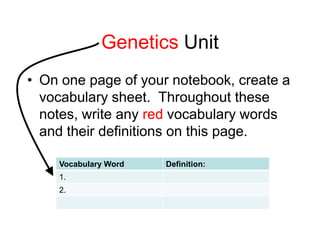
Genetics model 2012 fields part 1
- 1. Genetics Unit • On one page of your notebook, create a vocabulary sheet. Throughout these notes, write any red vocabulary words and their definitions on this page. Vocabulary Word Definition: 1. 2.
- 2. Gregor Mendel • Austrian Monk • Studied pea plants
- 3. Mendel’s Crossbreeding Trait Dominant Recessive Allele Allele Seed Shape Round Wrinkled Seed Color Yellow Green Seed Coat Gray White Color Pod Shape Smooth Constricted Pod Color Green Yellow Flower Axial Terminal Position Plant Height Tall Short
- 4. Trait Dominant Recessive Allele Allele
- 5. Inheritance Gregor Mendel – “Father of Genetics” • Experimented with pea plants in 1850’s to show basic patterns of inheritance Seed Shape (round or wrinkled) Seed Color (yellow or green) Seed Coat color (gray or white) Pod Shape (smooth or constricted) Pod Color (green or yellow) Flower Position (axial or terminal) Plant Height (tall or short) Traits Alleles
- 6. Inheritance Gregor Mendel – “Father of Genetics” • Did experiments with pea plants in mid-late 1800’s to show basic patterns of inheritance Seed Shape (round or wrinkled) Seed Color (yellow or green) Seed Coat color (gray or white) Pod Shape (smooth or constricted) Found that when two plants Pod Color (green or yellow) with different alleles are Flower Position (axial or terminal) crossed, the offspring look Plant Height (tall or short) like one of the parents, rather than a blending of both parents. Dominant Recessive Principle of Dominance Alleles Alleles Some alleles are dominant and others are recessive
- 7. Inheritance Gregor Mendel – “Father of Genetics” • Did experiments with pea plants in mid-late 1800’s to show basic patterns of inheritance Seed Shape (round or wrinkled) Seed Color (yellow or green) Seed Coat color (gray or white) Pod Shape (smooth or constricted) Found that when two plants Pod Color (green or yellow) with different alleles are Flower Position (axial or terminal) crossed, the offspring look Plant Height (tall or short) like one of the parents, rather than a blending of both Traits Alleles parents. Dominant Recessive Principle of Dominance Alleles Alleles Some alleles are dominant and others are recessive
- 8. Inheritance: the passing of traits from parents to offspring Gregor Mendel – “Father of Genetics” • Phenotype - The observable physical characteristic of a trait • Genotype - The genetic combination of alleles for a trait • Punnett Square – tool used to predict probability of phenotype Phenotype: White Genotype: pp Phenotype: Purple Genotype: PP Notice that letters are used to represent the alleles (usually correspond to the dominant phenotype – e.g. “P” for purple) Upper Case Letters = Dominant Allele Lower Case Letters = Recessive Allele
- 9. Practice • Overview of genes to traits video • Copy the 3 questions below: • What do they mean when the say “you have your father’s hair”? • How many chromosomes do organisms have? • How much DNA do we have in common with other animals?
- 10. • Complete the Phenotype Survey and write the results in your notebook.
- 11. Inheritance Gregor Mendel – “Father of Genetics” • Found that alleles show up in predictable patterns and that some alleles show up more often than others • Homozygous (Pure-Breeds) - both alleles are the same • Heterozygous (Hybrids) - both alleles are different • Carriers – heterozygotes for a recessive trait Pure-Breed Crosses result in: Hybrid Crosses result in: 100% chance dominant phenotype 75% chance dominant phenotype 25% chance recessive phenotype
- 12. Inheritance Gregor Mendel – “Father of Genetics” • Found that alleles show up in predictable patterns and that some alleles show up more often than others • Alleles can be tracked through multiple generations and probabilities determined Parents: P1 generation First Generation: First Filial (F1) 100% chance dominant phenotype Second Generation: Second Filial (F2) 75% chance dominant phenotype Third Generation: Third Filial (F3) 63% chance dominant phenotype 100% chance 75% chance 75% chance 0% chance
- 13. Practice • Video on making punnett squares • In your notebook complete the Probability (Long vs Short Big Toe) Lab.
- 14. Summary of Mendel’s Principles Gregor Mendel’s work forms the basis of modern genetics: • Genes are passed from parent to offspring • Some forms of genes (alleles) are dominant while others are recessive • Genes randomly segregate (independent assortment) when gametes are formed • The alleles for different genes usually segregate independently of one another Linked genes (genes that occur very close to one another on a chromosome) are the exception Write these 4 ideas from Mendel in your notebook
